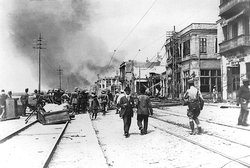This article needs additional citations for verification. (March 2011) |



The Great Thessaloniki Fire of 1917 (Greek: Μεγάλη Πυρκαγιά της Θεσσαλονίκης, 1917) destroyed two thirds of the city of Thessaloniki, the second-largest city in Greece, leaving more than 70,000 homeless.[1] The fire burned for 32 hours and destroyed 9,500 houses within an extent of 1 square kilometer. Half the Jewish population emigrated from the city as their livelihoods were gone. Rather than quickly rebuilding, the government commissioned the French architect Ernest Hébrard to design a new urban plan for the burned areas and for the future expansion of the city. His designs are still evident in the city, most notably Aristotelous Square, although some of his most grandiose plans were never completed due to a lack of funds. French navy official Dufour de la Thuillerie writes in his report that "I saw Thessaloniki, a city of more than 150,000 people, burn".[1]
- ^ a b Gerolympos, Alexandra Karadimou. (1995) The Redesign of Thessaloniki after the Fire of 1917. (Thesis). University of Thessaloniki. p. 133-137, 166 (in Greek)